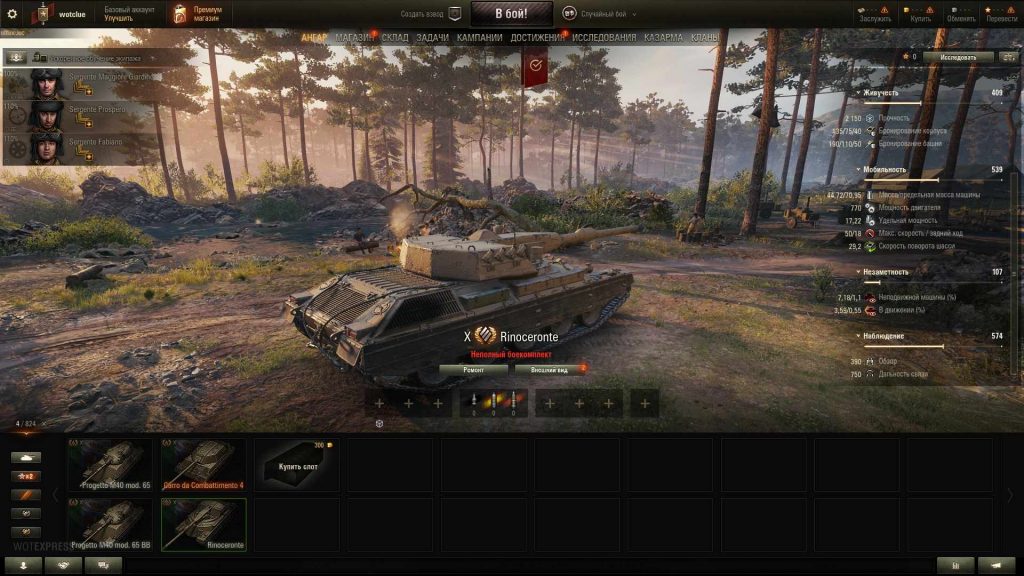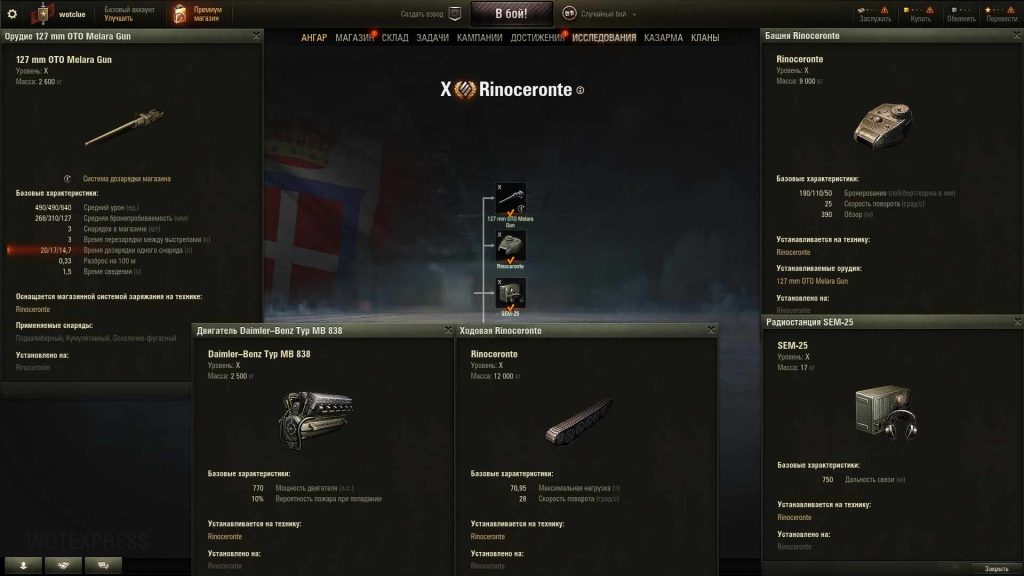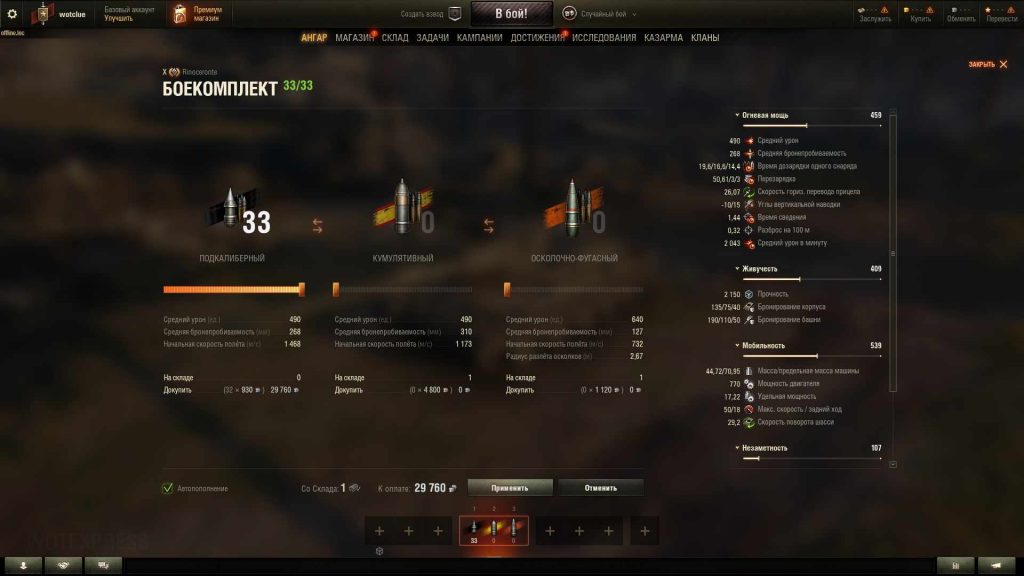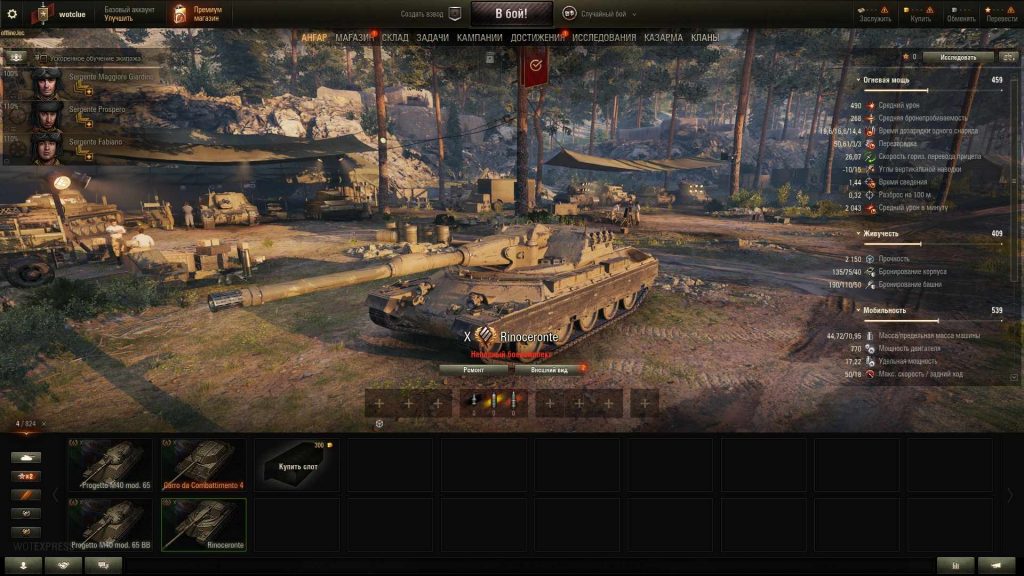Rinoceronte (Italy, HT-10, upgradeable, mechanics: modified reloading mechanism).
Separate performance characteristics:
• Reload time for the first round: 19.6
• Reload time for the second projectile: 16.6
• Recharge time for the third projectile: 14.4
• Reload between shots: 3
• Reload the entire magazine: 50.61
* TTX are indicated from 100 % by the crew.
Performance characteristics, comparison and appearance of the tank in front of you:
Tier: HT-10, Italy, standard
Health: 2,150
Engine power: 770 hp
Weight: 44.72 t
Maximum load: 70.95 tons
Power per ton: 17.22 KM / t
Maximum speed / Reverse speed: 50 / – 18 km / h
Rotation speed: 29.2 ° / s
Turret rotation speed: 26.07 ° / s
Ground resistance: – / – / –
View range: 390 m
Signal range: 750 m
Hull armor: 135/75/40
Turret armor: 190/110/50
Gun: 127 mm OTO Melara Gun
Damage: 490/490/640
Penetration: 268/310/127
Rate of fire: –
Average damage per minute: 2 043
Rounds in magazine: 3 pcs.
Reload time between shots: 3.0 s
One shell reload time: 19.6 / 16.6 / 14.4 s
Time for full reload: 50.61 s (Time between firing the last shell in the magazine and loading a new magazine)
Dispersion at 100 m: 0.32
Aiming time: 1.44 s
Gun depression / elevation limits: -10 ° / +15 °
Shells: 33 pcs.
3-person crew: Commander, Driver-mechanic and Gunner.
Special category equipment: Survival. Price: 6,100,000 silver.
Camouflage Value:
- Masking a stationary vehicle: 7.18 / 1.1% (for a stationary vehicle / for a stationary vehicle after firing a shot);
- Masking the vehicle in motion: 3.59 / 0.55% (for a moving vehicle / for a moving vehicle after firing a shot).
History: at the turn of the 1960s and 70s, tanks with uninhabited turrets were being developed in a number of countries – in this way they tried to increase the survivability of crews. These latest developments were not ignored by the Italian military either, but they took an easier path, taking existing developments as a basis. It was decided to develop the tower on the basis of the German tower of the promising KPz 3 tank. The general layout of the hull was also borrowed from the Germans. At the same time, the designers tried to maximize the armor component. To increase the projectile resistance of the hull’s forehead, it was decided to make it in a shape similar to the “pike nose”. The work was stopped at the drawing stage.
Rinoceronte (Italia, HT-10, ricercabile, meccanica: meccanismo di ricarica modificato).
Caratteristiche di prestazione separate:
• Tempo di ricarica per il primo round: 19,6
• Tempo di ricarica per il secondo proiettile: 16,6
• Tempo di ricarica per il terzo proiettile: 14,4
• Ricarica tra i colpi: 3
• Ricarica l’intera rivista: 50.61
* TTX sono indicati al 100% dall’equipaggio.
Caratteristiche prestazionali, confronto e aspetto del carro di fronte a voi:
Tier: HT-10, Italia, standard
HP: 2.150
Potenza motore: 770 hp
Peso: 44,72 t
Carico massimo: 70,95 tonnellate
Potenza per tonnellata: 17,22 KM / t
Velocità massima / Velocità retromarcia: 50 / – 18 km / h
Velocità di rotazione: 29,2 ° / s
Velocità di rotazione torretta: 26,07 ° / s
Resistenza al terreno: – / – / –
Raggio di visualizzazione: 390 m
Portata del segnale radio: 750 m
Corazza scafo: 135/75/40
Corazza torretta: 190/110/50
Cannone: Melara OTO da 127 mm
Danno: 490/490/640
Penetrazione: 268/310/127
Velocità di fuoco: –
Danno medio al minuto: 2 043
Colpi nel caricatore: 3 pezzi
Tempo di ricarica tra i colpi: 3,0 s
Tempo di ricarica di un proiettile: 19,6 / 16,6 / 14,4 s
Tempo di ricarica completa: 50,61 s (tempo tra lo sparo dell’ultimo proiettile nel caricatore e il caricamento di un nuovo caricatore)
Dispersione a 100 m: 0,32
Tempo di puntamento: 1,44 s
Limiti di depressione / elevazione: -10 ° / +15 °
Proiettili: 33 pezzi
- Equipaggio di 3 persone: comandante, autista-meccanico e artigliere.
- Prezzo: 6.100.000 crediti.
Valore mimetico:
- Mascheramento di un veicolo fermo: 7,18 / 1,1% (per un veicolo fermo / per un veicolo fermo dopo aver sparato un colpo);
- Mascheramento del veicolo in movimento: 3,59 / 0,55% (per un veicolo in movimento / per un veicolo in movimento dopo aver sparato un colpo).
Storia : a cavallo degli anni ’60 e ’70, i carri armati con torrette disabitate venivano sviluppati in un certo numero di paesi – in questo modo si cercava di aumentare la sopravvivenza degli equipaggi. Anche questi ultimi sviluppi non sono stati ignorati dai militari italiani, ma hanno preso una strada più facile, prendendo come base gli sviluppi esistenti. Si è deciso di sviluppare la torre sulla base della torre tedesca del promettente carro armato KPz 3. Anche la disposizione generale dello scafo fu presa in prestito dai tedeschi. Allo stesso tempo, i progettisti hanno cercato di massimizzare la componente della corazza. Per aumentare la resistenza dei proiettili della fronte dello scafo, si è deciso di realizzarlo in una forma simile al “naso di luccio”. Il lavoro è stato interrotto in fase di disegno .




